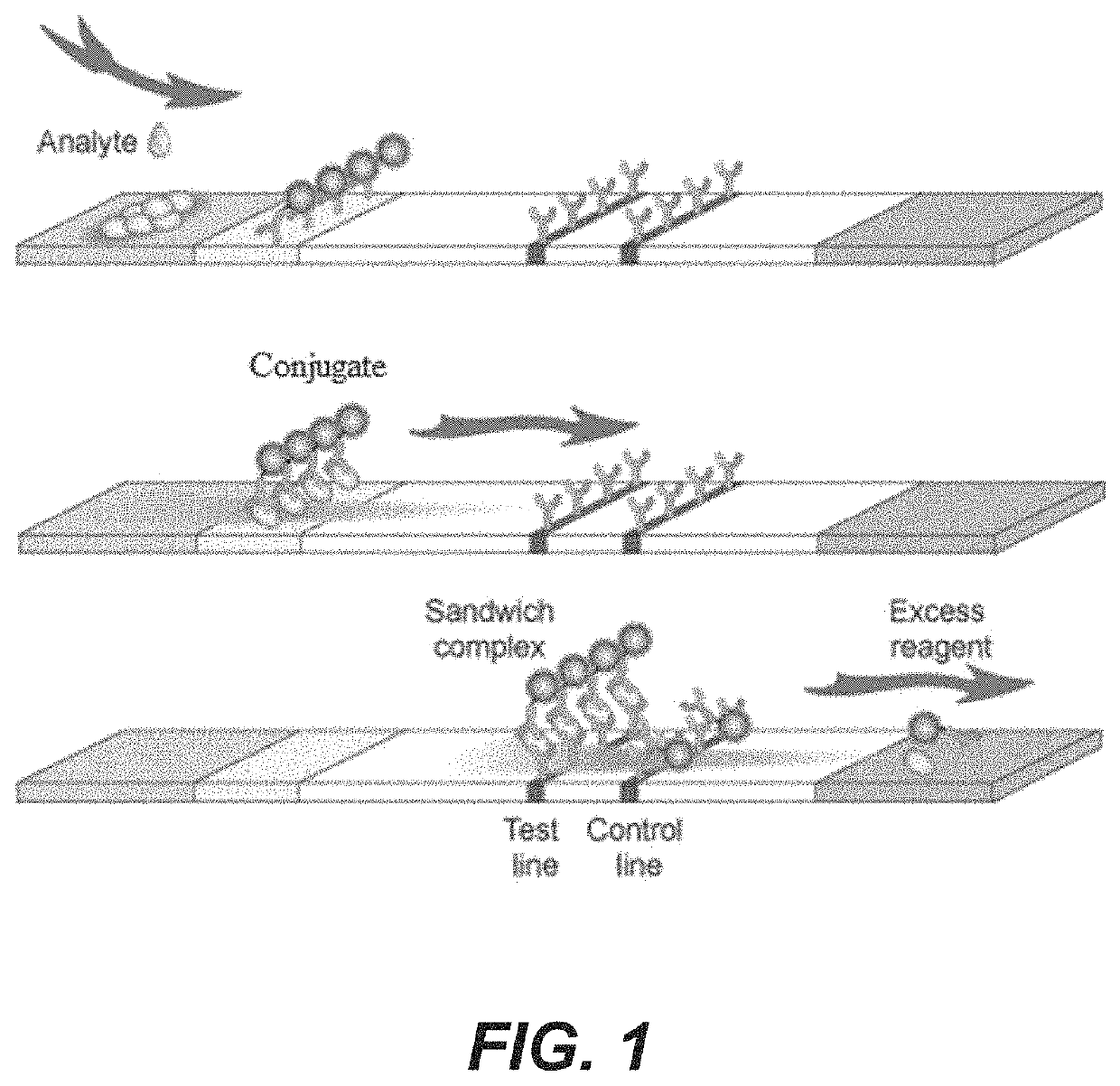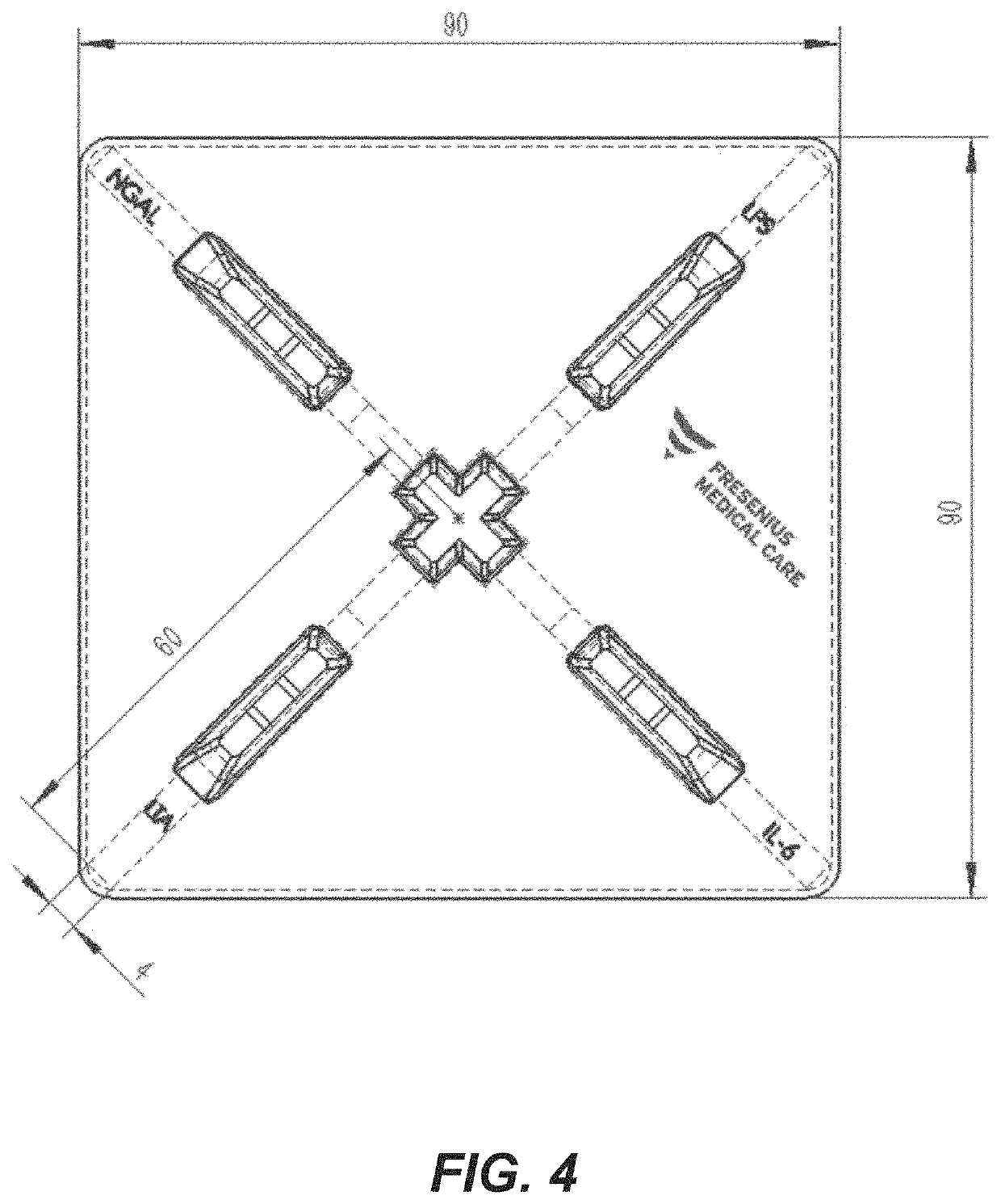Rapid diagnosis of peritonitis in peritoneal dialysis patients
a technology for peritoneal dialysis and rapid diagnosis, applied in the field of medical devices, can solve the problems of peritonitis being a major cause of morbidity and mortality in peritoneal dialysis, increased risk of drug-resistant bacteria, and simple device not available to at-home peritoneal dialysis patients or dialysis clinic clinicians, so as to improve the management of peritoneal dialysis-related peritonitis
- Summary
- Abstract
- Description
- Claims
- Application Information
AI Technical Summary
Benefits of technology
Problems solved by technology
Method used
Image
Examples
example i
[0119]The assay of FIGS. 1-3 is made with the following antibody components incorporated into a paper-based (e.g., nitrocellulose) LFD:
BindingMolecule(s)SupplierProduct No.ReferenceAnti-IL-6R&D SystemsMAB206 (Capture)Cell. Physiol.614 McKinley Place NEBiochem., 2017;Minneapolis, MN 5541342(5): 1961-1972R&D SystemsBAF206 (Detection)Cell. Physiol.614 McKinley Place NEBiochem., 2017;Minneapolis, MN 5541342(5): 1961-1972Abcamab48478 (Pair)1 Kendall Square, Suite B2304Cambridge, MA 02139-1517Anti-NGALR&D SystemsMAB17571 (Capture)614 McKinley Place NEMinneapolis, MN 55413R&D SystemsBAF1757 (Detection)J. Neurosci. 2016;614 McKinley Place NE36(20): 5608-22Minneapolis, MN 55413Abcamab220126 (Pair)1 Kendall Square, Suite B2304Cambridge, MA 02139-1517Anti-LPSMeridian BioscienceC55308M3471 River Hills DriveCincinnati, OH 45244Anti-LTAMeridian BioscienceC65380M *3471 River Hills DriveCincinnati, OH 45244Meridian BioscienceC65813M *3471 River Hills DriveCincinnati, OH 45244Anti-Staph.Abcamab37644...
example ii
[0122]Protocol—Rapid PD-related peritonitis diagnosis at dialysis clinic or home (following the flow diagram of FIG. 6).
[0123]Background: When a PD patient displays any sign of peritonitis (e.g., cloudy PDE, abdominal pain, and / or fever), he or she is to visit a dialysis clinic or doctor as soon as possible. Upon presentation at the dialysis clinic, the nurse or other health care professional drains the PD effluent into a waste bag and collects samples for routine testing such as cell count, gram stain, and culture. Alternatively, a PD patient may collect and test samples using the disclosed assay and device before going to a dialysis clinic or doctor. What follows is rapid testing of the same PDE sample before it is sent for routine testing (e.g., cell culture, Gram stain, cell count, etc.)[0124]1. Process[0125]1.1 Equipment and reagents[0126]1. PPE (“Personal Protective Equipment”)[0127]2. Testing kit contains:[0128]A sterile 50 mL syringe with a needle pre-attached[0129]A sterile...
example iii
Enrichment by UF Membrane
[0154]25 ml of PDE is placed into a container for centrifugation, which is separated into an upper chamber and a lower chamber by an ultrafiltration (“UF”) membrane having a molecular weight cutoff of 29,000. The container is capped and placed into a centrifuge and spun (×4000 g). The PDE is filtered through the UF membrane and pushed from the upper chamber to the lower chamber, creating an enriched PDE.
[0155]A few drops of the enriched PDE are placed onto the sample port of the IL-6 / NGAL panel of the device of EXAMPLE I, and any reaction is determined.
[0156]The UF membrane is mixed with elution buffer, and a few drops are placed onto the sample port of the LPS / LTA panel of the device of EXAMPLE I, and any reaction determined.
PUM
| Property | Measurement | Unit |
|---|---|---|
| height | aaaaa | aaaaa |
| height | aaaaa | aaaaa |
| height | aaaaa | aaaaa |
Abstract
Description
Claims
Application Information
 Login to View More
Login to View More - R&D
- Intellectual Property
- Life Sciences
- Materials
- Tech Scout
- Unparalleled Data Quality
- Higher Quality Content
- 60% Fewer Hallucinations
Browse by: Latest US Patents, China's latest patents, Technical Efficacy Thesaurus, Application Domain, Technology Topic, Popular Technical Reports.
© 2025 PatSnap. All rights reserved.Legal|Privacy policy|Modern Slavery Act Transparency Statement|Sitemap|About US| Contact US: help@patsnap.com



